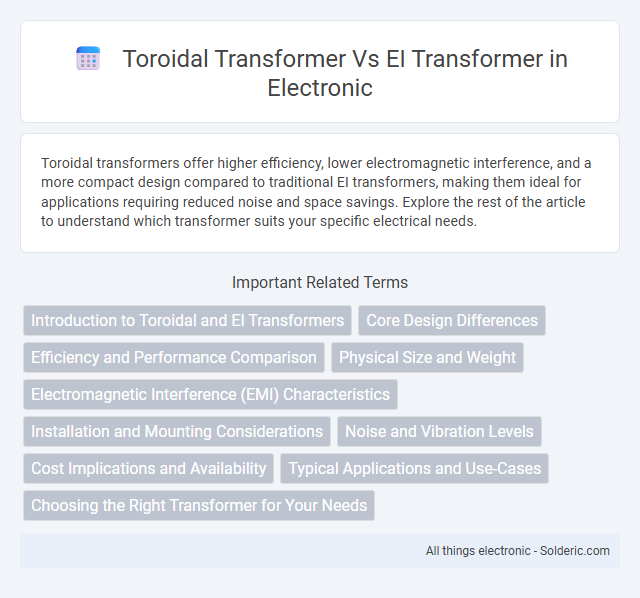Toroidal transformers offer higher efficiency, lower electromagnetic interference, and a more compact design compared to traditional EI transformers, making them ideal for applications requiring reduced noise and space savings. Explore the rest of the article to understand which transformer suits your specific electrical needs.
Comparison Table
| Feature | Toroidal Transformer | EI Transformer |
|---|---|---|
| Core Shape | Doughnut-shaped (Toroid) | E-I laminated core |
| Magnetic Flux Leakage | Low flux leakage | Higher flux leakage |
| Size & Weight | Compact and lightweight | Larger and heavier |
| Efficiency | High efficiency (up to 98%) | Moderate efficiency (around 85-95%) |
| Noise Level | Low audible hum | Higher audible hum |
| Manufacturing Cost | Higher manufacturing cost | Lower manufacturing cost |
| Applications | Audio equipment, medical devices, sensitive electronics | Power supplies, lighting, general purpose |
| Mounting | Requires special mounting clamps | Standard mounting on chassis |
| Thermal Performance | Better heat dissipation due to shape | Less efficient heat dissipation |
| Overcurrent Tolerance | Usually lower tolerance | Higher overcurrent tolerance |
Introduction to Toroidal and EI Transformers
Toroidal transformers feature a doughnut-shaped core made from a continuous strip of silicon steel, minimizing magnetic flux leakage and improving efficiency compared to traditional EI transformers with laminated E- and I-shaped cores. The compact design of toroidal transformers allows for lower electromagnetic interference and quieter operation, making them ideal for sensitive electronic applications. Your choice between the two depends on factors like size requirements, efficiency needs, and cost constraints, with EI transformers often favored for ruggedness and ease of manufacture.
Core Design Differences
Toroidal transformers feature a doughnut-shaped core made of continuous strips of grain-oriented silicon steel, providing low magnetic flux leakage and high efficiency due to uniform core geometry. EI transformers have a laminated E-shaped and I-shaped core assembled together, which tends to produce higher magnetic flux leakage and increased audible hum compared to toroidal designs. The continuous core of toroidal transformers reduces stray magnetic fields, enhancing energy transfer and minimizing electromagnetic interference relative to the segmented core in EI transformers.
Efficiency and Performance Comparison
Toroidal transformers offer higher efficiency due to their continuous core design, which reduces core losses and electromagnetic interference compared to EI transformers. EI transformers typically have a laminated core with gaps, resulting in higher core losses and less efficient magnetic flux conduction. Consequently, toroidal transformers provide better performance in sensitive electronic applications demanding low noise and minimal power loss.
Physical Size and Weight
Toroidal transformers are typically smaller and lighter than EI transformers due to their compact doughnut-shaped core, which allows for efficient magnetic flux distribution and reduced core material. EI transformers have a bulky rectangular laminated core, resulting in larger physical size and heavier weight for equivalent power ratings. The reduced weight and size of toroidal transformers make them ideal for applications where space and weight constraints are critical.
Electromagnetic Interference (EMI) Characteristics
Toroidal transformers exhibit significantly lower Electromagnetic Interference (EMI) compared to EI transformers due to their continuous ring-shaped core that confines magnetic flux more effectively, reducing stray fields. This design minimizes radiated noise and electromagnetic emissions, making toroidal transformers preferable in sensitive electronic applications. Choosing a toroidal transformer can enhance your device's performance by ensuring cleaner power delivery and reduced interference with nearby circuits.
Installation and Mounting Considerations
Toroidal transformers offer a compact, lightweight design that simplifies installation, with mounting achieved via a central bolt, reducing space requirements and vibration transmission. EI transformers typically require larger mounting brackets due to their bulkier shape and heavier core, which may increase installation complexity and floor or panel space usage. Your choice will impact ease of maintenance and the overall footprint within your electrical enclosure.
Noise and Vibration Levels
Toroidal transformers exhibit significantly lower noise and vibration levels due to their symmetrical core design and continuous winding, which minimizes magnetostriction and reduces hum. EI transformers, with their laminated core structure and stepped laminations, tend to produce higher audible noise and vibration because of magnetostriction at the joints and mechanical resonance. This makes toroidal transformers preferable in noise-sensitive applications such as audio equipment and medical devices.
Cost Implications and Availability
Toroidal transformers generally have higher manufacturing costs due to their complex winding process and require specialized materials, making them more expensive than EI transformers. EI transformers are widely available and more cost-effective, benefiting from mass production and simpler design, which suits budgets with strict cost constraints. Your choice will depend on balancing the premium price of toroidal units against the greater availability and affordability of EI transformers.
Typical Applications and Use-Cases
Toroidal transformers are preferred in audio equipment, medical devices, and precision instruments due to their low electromagnetic interference and compact size. EI transformers are commonly used in power supplies, industrial machinery, and household appliances for their robustness and ease of manufacturing. The choice depends on the need for efficiency, noise reduction, and physical form factor in applications.
Choosing the Right Transformer for Your Needs
Selecting the right transformer depends on factors such as efficiency, size, and noise levels, with toroidal transformers offering higher efficiency, compact design, and lower electromagnetic interference compared to EI transformers. EI transformers are typically more cost-effective and easier to manufacture, making them suitable for applications requiring robust mechanical construction and lower initial investment. Understanding your specific power requirements and space constraints will guide the choice between the quiet, energy-saving toroidal transformer and the economically practical EI transformer.
toroidal transformer vs EI transformer Infographic

 solderic.com
solderic.com